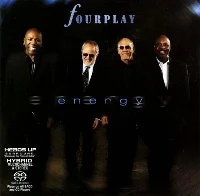Styles: Piano Jazz
Year: 2006
File: MP3@320K/s
Time: 59:13
Size: 136,1 MB
Art: Front
( 8:05) 1. Lambada de Serpente
( 8:31) 2. Taurus
( 2:27) 3. Kianda's Song
( 5:05) 4. Unstablemates
( 5:10) 5. Modinha
( 5:28) 6. Salvador
( 4:26) 7. Oam's Blues
( 6:57) 8. Inutil Paisagem
(11:01) 9. Oud To Omer
( 1:58) 10. Between Worlds
Worlds
Year: 2006
File: MP3@320K/s
Time: 59:13
Size: 136,1 MB
Art: Front
( 8:05) 1. Lambada de Serpente
( 8:31) 2. Taurus
( 2:27) 3. Kianda's Song
( 5:05) 4. Unstablemates
( 5:10) 5. Modinha
( 5:28) 6. Salvador
( 4:26) 7. Oam's Blues
( 6:57) 8. Inutil Paisagem
(11:01) 9. Oud To Omer
( 1:58) 10. Between Worlds
Man, am I glad that pianist Aaron Goldberg and I never tried to apply for the same job. I'm not a musician, but you should see this guy's CV. While he was double-majoring at Harvard in history and science plus mind, brain and behavior, he was working with Betty Carter, gigging weekends in Boston and winning all kinds of awards, including the formidable-sounding Clifford Brown/Stan Getz Fellowship. After graduation (magna cum laude), he moved to New York and played with a bunch of top names, among them Joshua Redman. What next? Goldberg was a member of Wynton Marsalis's quintet and the Lincoln Center Jazz Orchestra. Ah, well, now we're onto something: he's one of those young fogeys, all chops and no soul. But, you know, the problem with this critique of the young conservatives is that, sure, Stanley Crouch (an intellectual guru to some) can be a pompous ass, but most of the players are damn good and indeed quite soulful. (And don't misunderstand me, Mr. Crouch: I mean that you are an often brilliant pompous ass.)
So, what about Worlds, Goldberg's third recording as leader? Is he stuck in the past? It's true that, listening to this album, you might think history had stopped with Everybody Digs Bill Evans. But for as long as the record is playing, these guys will have you convinced that maybe history should have stopped in 1958. Goldberg's playing is just delectable from start to finish. Admirers of Cecil Taylor or Marilyn Crispell might feel a kind of guilty pleasure digging his apparently retrograde style, but no guilt is necessary, and there's nothing retrograde about the style, either. The upside of the postmodern character of contemporary jazz is that all these stylistic strata can be sampled simultaneously. If you value the great piano trios, of which Evans's was surely the avatar, then go ahead and wallow in this trio's mastery of the idiom. And Goldberg's embrace of explicit and implicit Brazilian references contributes mightily to the unity and exuberance with which that mastery is expressed.
An essential ingredient in this record's success is the endlessly inventive interplay among the trio members: bassist Reuben Rogers and especially drummer Eric Harland play just as well as the leader, reminding us of the critical role played by bassists and drummers in great piano trios of times past. (Their CVs are not included in the press kit, but I'm reasonably confident that between them they hold a couple of biotechnology patents and/or Ivy League diplomas.) Plenty of young players are remarkably good sidemen, but it's relatively unusual that so young a leader can convey and communicate so coherent a musical vision over the length of an album. ~ Jeff Dayton-Johnson http://www.allaboutjazz.com/worlds-aaron-goldberg-sunnyside-records-review-by-jeff-dayton-johnson.php
Personnel: Aaron Goldberg: piano; Reuben Rogers: bass; Eric Harland: drums; Luciana Souza: vocals (3); Kurt Rosenwinkel: guitar (9).
So, what about Worlds, Goldberg's third recording as leader? Is he stuck in the past? It's true that, listening to this album, you might think history had stopped with Everybody Digs Bill Evans. But for as long as the record is playing, these guys will have you convinced that maybe history should have stopped in 1958. Goldberg's playing is just delectable from start to finish. Admirers of Cecil Taylor or Marilyn Crispell might feel a kind of guilty pleasure digging his apparently retrograde style, but no guilt is necessary, and there's nothing retrograde about the style, either. The upside of the postmodern character of contemporary jazz is that all these stylistic strata can be sampled simultaneously. If you value the great piano trios, of which Evans's was surely the avatar, then go ahead and wallow in this trio's mastery of the idiom. And Goldberg's embrace of explicit and implicit Brazilian references contributes mightily to the unity and exuberance with which that mastery is expressed.
An essential ingredient in this record's success is the endlessly inventive interplay among the trio members: bassist Reuben Rogers and especially drummer Eric Harland play just as well as the leader, reminding us of the critical role played by bassists and drummers in great piano trios of times past. (Their CVs are not included in the press kit, but I'm reasonably confident that between them they hold a couple of biotechnology patents and/or Ivy League diplomas.) Plenty of young players are remarkably good sidemen, but it's relatively unusual that so young a leader can convey and communicate so coherent a musical vision over the length of an album. ~ Jeff Dayton-Johnson http://www.allaboutjazz.com/worlds-aaron-goldberg-sunnyside-records-review-by-jeff-dayton-johnson.php
Personnel: Aaron Goldberg: piano; Reuben Rogers: bass; Eric Harland: drums; Luciana Souza: vocals (3); Kurt Rosenwinkel: guitar (9).
Worlds




















